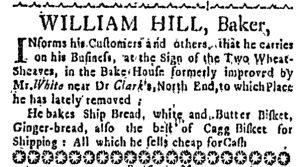What was advertised in a colonial American newspaper 250 years ago today?

“At the Sign of the Two Wheat-Sheaves.”
According to his advertisement in the Massachusetts Gazette, William Hill, a baker in Boston, made and sold “Ship Bread,” biscuits, and gingerbread at “the Bake House” appropriately marked with “the Sign of the Two Wheat-Sheaves.” In an era before standardized street numbers organized the streets of towns and cities, shop signs helped both entrepreneurs and customers identify and locate businesses of all sorts. Some shopkeepers and artisans also used the devices depicted on their signs as rudimentary brands, sometimes adopting similar visual images in newspaper advertisements as well as on magazine wrappers, trade cards, and billheads.
Not every advertiser had his or her own shop sign, but that did not prevent them from using the signs of others who ran businesses nearby as landmarks to guide potential customers to their own shops. In the same issue that Hill promoted the breads he sold “at the Sign of the Two Wheat-Sheaves,” Nathaniel Cudworth reported that he kept shop “in KING-STREET, opposite the Sign of Admiral Vernon.” Similarly, Joseph Domett gave the location of his store as “nearly opposite the GOLDEN BALL.” That Domett gave no other directions, not even a street name, suggests the Golden Ball was widely recognized by residents of Boston. The shopkeeper expected potential customers to already be familiar with that landmark, a common point of reference for advertiser and reader alike.
Even without woodcuts depicting the Sign of the Two Wheat-Sheaves, the Golden Ball, or the Sign of Admiral Vernon, the advertisements reveal some of the visual culture of eighteenth-century streets. Advertisements in the Massachusetts Gazette and other newspapers published in Boston named dozens of signs present in the city in 1767, a vibrant display that served several purposes but now can only be imagined. Sighting various signs aided colonists as they navigated through cities. Signs also enticed colonists to become customers as they encountered them because marketing efforts encouraged consumers to associate certain signs with particular businesses and the men and women who ran them.
